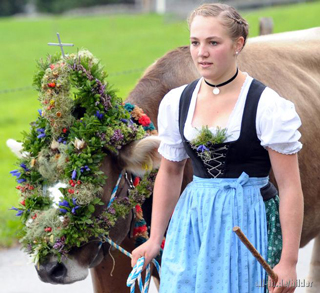The National Maritime Museum has a new gallery entitled ‘Trade Routes’ on the East India Company. There’s a couple of really nice associated videos on agrobiodiversity themes: tea and spices. No word on whether opium is in the offing.
Nibbles: Maize, David Douglas, Globesity, Iron-rice rice, Miracle berry, Trout vs cows
- Farmer Brian Schaumburg has planted corn for five straight years in some of the thousands of acres he tends in central Illinois. Good thinking; it’s non-native, and it’s a monoculture.
- Douglas of the Douglas Fir remembered.
- Tom tackles “globesity“.
- Enriching rice with iron and zinc using rice’s own genes. Because they can.
- How Richadella dulcifica works its miracles.
- In the contest between fish and bovine, the outcome is not always certain.
Now that’s what I call a celebration of biodiversity

What goes up, must come down. Alpine farmers who take their livestock to higher pastures in the spring bring them down for the winter. The Human Flower Project shares the celebratory mood.
Brainfood: Breeding resistance, Pastures, Wheats, Dates, Conservation, Habitats, Old olives, Spinach selection, Maize breeding
- Cytological and Molecular Characterization of Homoeologous Group-1 Chromosomes in Hybrid Derivatives of a Durum Disomic Alien Addition Line. Getting tolerance to Fusarium head blight into durum wheat ain’t easy.
- Sustainable, low-input, warm-season, grass–legume grassland mixtures: mission (nearly) impossible? Apparently really difficult to find native North America legume forage species tolerant of both freezing and high temperatures, but people are looking. Gotta wonder if it’s a problem elsewhere too. Ethiopian highlands?
- Diversity of different farmer and modern wheat varieties cultivated in contrasting organic farming conditions in western Europe and implications for European seed and variety legislation. Strong selection for uniformity (for regulation) is not reflected in uniformity assessed on farm. And farmer varieties were good outside their region of origin.
- Glycaemic index of three Indian rice varieties. All three the same, high, GI. So, “There is an urgent need to study the GI of other commonly consumed rice varieties and to develop rice of a lower GI value”. Er, right.
- Glycemic indices of five varieties of dates in healthy and diabetic subjects. All five the same, low, GI and no difference in diabetics.
- Agricultural expansion and the fate of global conservation priorities. Conservation needs to think about agriculture.
- Which habitats of European importance depend on agricultural practices? 63 of them, mainly through grazing and mowing.
- Centennial olive trees as a reservoir of genetic diversity. Only about 10% of old trees matched current cultivars.
- Phenotypic Changes in Different Spinach Varieties Grown and Selected under Organic Conditions. There were phenotypic changes after just three seasons of selection, in one case resulting in a “new” variety.
- Open-Pollinated vs. Hybrid Maize Cultivars. Hybrids are not the only way to improve maize productivity, apparently.
- Plant breeding for harmony between agriculture and the environment. “Plant breeding can be a powerful tool to bring “harmony” between agriculture and the environment, but partnerships between plant breeders, ecologists, urban planners, and policy makers are needed to make this a reality.” I was just going to ask, why can’t we all just get along.
Don’t forget the open Mendeley group for the papers we link to here. Even if you don’t use Mendeley, you can subscribe to the RSS feed from the group and get stuff that way.
Nibbles: Elm disease, Kew genebank, Maize domestication, Wildlife vs livestock, Medieval figs, Alternative food security, Spineless lulo, Mangos for Haiti, Aubergine breeding, Urban ag in Japan, West African research
- “Beginning in the late 1990s, Kock travelled throughout Ontario collecting twigs of seemingly healthy mature elms, in what amounted to an elm dating service.”
- “…a curated inventory of miscellaneous interestingness” lands on the Millennium Seed Bank. Hilarity ensues.
- What do hopscotch, architecture and maize have in common?
- Zebras good for cattle.
- The fig deconstructed.
- “Improve yields through crop diversity…” ??? Who are these people?
- Crops for the Future bemoans the loss of “a spineless variety of Solanum quitoense.” Someone, somewhere must still have it, surely.
- Mangos: Haiti’s new best friend?
- Home-bred eggplants. Or aubergines.
- “Urban agriculture in Japan, cultivating sustainability and well being.” Again? Still?
- West Africa to get bunch of specialist biotechnology centres for crop improvement. No word on where the existing national genebanks fit in. Nor, ahem, what role IITA, ICRISAT and the other CGIAR Centres are going to play in all this.